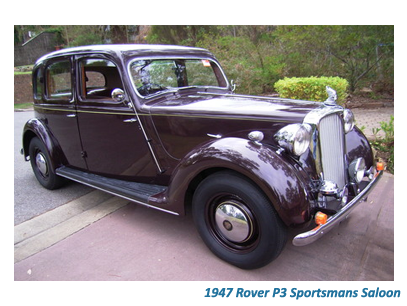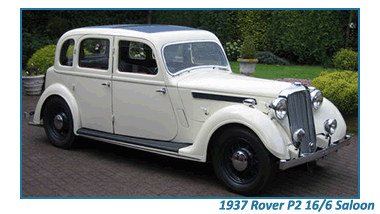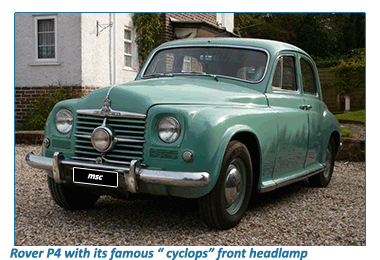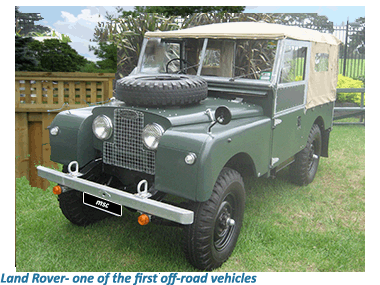
 Spurred on by the success of the bicycle manufacturing company, JK Starley, the driving force behind Rover, began producing some rudimentary motor vehicles cars in 1904, using a plant modified explicitly for the purpose, in the Midlands city of Coventry.
Spurred on by the success of the bicycle manufacturing company, JK Starley, the driving force behind Rover, began producing some rudimentary motor vehicles cars in 1904, using a plant modified explicitly for the purpose, in the Midlands city of Coventry.
From the outset, Starley named his new range of cars Rovers, with all of them carrying a Viking long ship logo.
By the mid-thirties, Rover had wrapped up their bicycle production division entirely, focusing on producing larger and much more luxurious cars.
Remaining independent and growing steadily prosperous throughout the harsh years of the Thirties, by 1939, with the outbreak of World War Two, Rover was well equipped in technical and financial terms to devote their considerable production facilities entirely over to the war effort.
 At the height of the bombing raids on England the Rover plant in Coventry was completely destroyed, a significant setback meaning that post-war operations could only get underway in a new plant in the industrial town of Solihull, to the southeast of Birmingham.
At the height of the bombing raids on England the Rover plant in Coventry was completely destroyed, a significant setback meaning that post-war operations could only get underway in a new plant in the industrial town of Solihull, to the southeast of Birmingham.
Probably more so than their counterparts in the UK auto manufacturing industry, Rover took their time to introduce new post-war models, meaning that cars designed before the outbreak of the Second World War and destruction of the factory were the first they had to offer, marketed as the Rover P2 series.
 Simultaneously, as something of an interim step, in 1948 the Rover company launched their basic workhorse -the Land Rover.
Simultaneously, as something of an interim step, in 1948 the Rover company launched their basic workhorse -the Land Rover.
The launch of the Land Rover proved to be inspired, becoming one of the best-selling vehicles in the history of the UK car industry.
Land Rovers are still produced today in some format or other all over the world.
![]()
nfortunately, accurate figures are unavailable on exactly how many Land Rovers were manufactured in its more than seven-decade long production run.
What is a fact that a few years ago the current owners of Land Rover, Tata Motors, proudly claimed that around 75 per cent of the vehicles ever sold were still working and travelling on the highways, country lanes and dirt tracks of the world.
 The successful launch of the Land Rover undoubtedly gave the Rover car company time to introduce new brands to take them into the Fifties.
The successful launch of the Land Rover undoubtedly gave the Rover car company time to introduce new brands to take them into the Fifties.
The first was the P4 series, released in I949, produced in no less than five permutations during the decade, mostly based on engine size and technical details, with the chassis and body in all models being virtually identical.
The P4 saloon first symbolised the vision of everything Spencer Wilks visualised for the company. Wilks was appointed as managing director at Rover just before the outbreak of World War Two.
 The P4 (which indicated that this was the first phase in a long-term plan of model development) was much like its predecessors, though it looked more modern and incorporated several mechanical innovations.
The P4 (which indicated that this was the first phase in a long-term plan of model development) was much like its predecessors, though it looked more modern and incorporated several mechanical innovations.
To keep pace of developing technology, Rover’s design and development were constantly making relevant design and technological changes and improvements.
![]()
With its a pleasingly rounded shape, the P4 series had obviously been built for comfort and not speed.
The only possible criticism that could be heaped on Rover’s design team was the placement of a single headlamp in the middle of the first version the P4 series to be released.
The media and soon after the public at large named this, the first version of the Rover P4, the `Cyclops.'
 The Cyclops look was done away with as part of the P4’s first facelift. Over its fifteen-year run externally the P4 series went through the most minimal of changes, basically having its rear end squared up a little and its small, oval shaped rear window resized.
The Cyclops look was done away with as part of the P4’s first facelift. Over its fifteen-year run externally the P4 series went through the most minimal of changes, basically having its rear end squared up a little and its small, oval shaped rear window resized.
Towards the end of the Fifties, Rover launched the larger and more luxurious P5 series, which again proved to be a steady seller well into the Sixties.
 The 3-litre engine was designed and produced to compete for sales coming dominated by Jaguar and Daimler and carried the distinction of being Rover's first car to be fitted with a monocoque body.
The 3-litre engine was designed and produced to compete for sales coming dominated by Jaguar and Daimler and carried the distinction of being Rover's first car to be fitted with a monocoque body.
The Land-Rover utility range, instituted in 1948, passed the 500,000-production mark on 1 April 1965, having earned more than 230 million pounds in foreign exchange during the interim period.
In 1966 Rover were presented with the Queen's Award to Industry in recognition of their sustained and substantial increases in exports over the previous three years.
In December of the same year Rover were approached by British Leyland Motor Corporation (BLMC) to discuss the possibility of a takeover bid.
This so called“friendly” take-over went smoothly, finalised in March 1967 at which point Rover became a wholly-owned subsidiary of BLMC.
Back to the homepage- and don't spare the horsepower.






